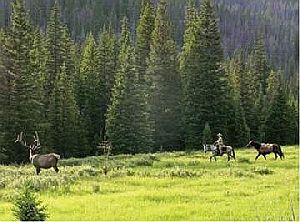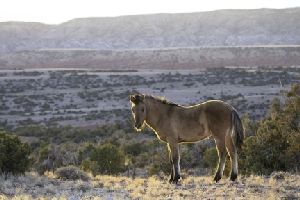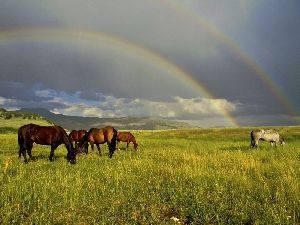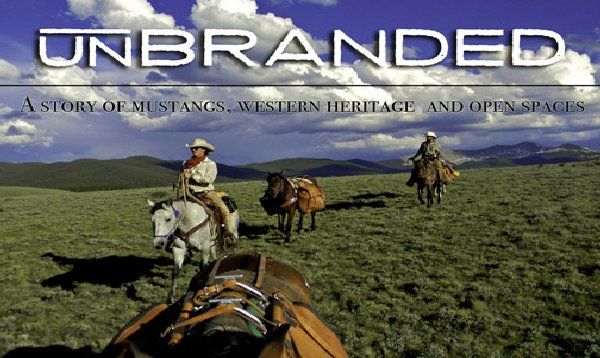Four guys, 18 wild mustangs, and 3,000 miles of open trail from Mexico to Canada sounds like the trip of a lifetime, and in many respects it is.
Using a trip of a lifetime to portray a positive and enduring message about conservation, being in the outdoors, and supporting mustang adoptions is what the makers of Unbranded are planing to do in March of this year.
Ben Masters, Johny Fitzsimons, Thomas Glover, and Ben Thamer are taking a six-month journey on horseback through some of the deepest backcountry in the American West and will be filming the expedition to create a 90-120 minute documentary aimed at inspiring mustang adoptions, raising conservation awareness, and getting people into the outdoors.
Masters and Glover spent time working at the Sombrero Stables in Grand Lake and Thamer worked at the Sombrero Stables in Estes Park. They also completed a similar trip that was 2,000 miles long and traveled through Rocky Mountain National Park in 2010.
“Hopefully seeing four guys ride across the country will inspire people to go out and have fun outdoors,” said Thamer, one of the four horsemen going on the ride.
 |
The Ride
The ride will begin just east of Nogales, Arizona, which is near the Mexican border. The four riders plan to travel between 15 to 30 miles a day, heading in a northward direction through Arizona, Utah, Idaho, Wyoming, and Montana.
The route was designed by the riders but uses much of the Arizona Trail, the Great Western Trail, and the Continental Divide Trail. The route will travel through some of the most famous scenic destinations in the country including Yellowstone, Glacier, and Grand Canyon national parks, which will make for awesome cinematography for the movie.
Ninety percent of the trail is off of any kind of road with the remainder of the trip being completed on four-wheel drive or logging roads.
Much of the route will use public lands such as national parks, wilderness, national forest, BLM, and state land.
Though these guys have a large amount of backcountry experience, they will be traveling through areas new to them so they will be planing for the unexpected as they will be a long ways away from help.
Nasty trails, high rivers, snowy passes, electrical storms, forest fires, and dangerous wildlife will be just a few of the dangers these horsemen will encounter on the long trail.
The Film
Unbranded will focus on the journey but will also provide information about the history of mustangs, conservation, and exploration.
They plan to shoot the movie in a format that will allow for the creation of a series if the film is successful. The film will be showcased at festivals throughout the country and then will be distributed to select theaters, Netflix, television networks, and by DVD.
A portion of the proceeds will go to the Mustang Heritage Foundation and various conservation groups that are habitat based.
The film will be shot in part by acclaimed cinematographers Denver Miller and Phill Baribeau. These two cinematographers have expertise and experience in capturing outdoor sports and they have traveled the world capturing footage for movies, networks such as National Geographic, and documentaries from skiing to nature. Miller has even filmed portions of the acclaimed Planet Earth series.
 |
The Horses
The reason these four experienced riders choose to ride wild mustangs is the ability of these horses to cope with the harsh environments they will encounter throughout the trip.
They choose these wild horses for “the same reason you hire a Sherpa to get up Everest,” Thamer said.
Mustangs are born and raised in the wild and are the horses of choice for a trip of this magnitude due to the fact that the ancestors of mustangs have endured and thrived in the harsh landscapes that they will be riding through for more than 300 years.
The bloodlines of these wild horses can be traced back to early Spanish explorations and have mingled with the bloodlines of Indian ponies, cow ponies, and cavalry stock.
"Its like God created the perfect horse for this and ran a 300 year test," Thamer said.
After 300 years of survival of the fittest, nature has created these tough footed, resilient, and intelligent mustangs.
Wild mustangs are rounded up by the Bureau of Land Management for population control and are then sorted and shipped to locations around the United States. There are more than 43,000 mustangs living in holding facilities around the country that are being fed government hay and waiting to be adopted. There is currently no legal solution to reduce the number of mustangs other than adoption.
The four riders hope to enlighten people to the plight of this majestic animal and inspire people to adopt a mustang by showing that they are trainable and are perfectly suited for mountain travel.
They will be using 11 completely untouched mustangs that they adopted and trained with the help of professional trainers Jerry Jones and Lanny Leach. Jones and Leach are certified trainers from the Mustang Heritage Foundation, an organization and program that helps find homes for mustangs.
They will also be using seven other mustangs that have been packing in the mountains for years and are proven reliable stock.
 |
The Mission
The four riders in the film hope to "produce a quality product so that our message of mustang adoptions and the need to conserve our public lands is portrayed to our audience," Thamer said.
"Every one of us has had a life-changing experience on our public lands and we want to make sure that it is there for a long time to come," he said.
The four hope the documentary will provide a powerful message about the benefits behind mustang adoption, conserving our natural world and public lands for future generations, and to inspire people to go out and experience our wild public lands
They intend to show there is still a huge amount of land in the West that is still wild. One of the main goals of the project is to show people that experiencing the public lands in our country is one of the greatest privileges we value as part of our freedoms. Too many people have become attached to their computers and smart phones and not enough people take the opportunity to enjoy our public lands, they say. This could inadvertently put these public lands at risk.
The creators of the project ernestly contend that "the great outdoors depend on people who value them."
The four hope to inspire people to chase their passions and appreciate what Mother Nature has to offer. They want to encourage people to go backpacking, rafting, trail riding, or whatever else tickles their fancy to utilize the wild places that make up our public lands.
Financing the Film
The men who are producing the film are seeking funding from a number of sources including corporate sponsorships, private investors, and grants. They are also collecting funds through a website called Kickstarter.
Kickstarter is an online funding platform for creative projects where an individual or group can set a number for the amount they hope to raise for their project and then people can back the project and make donations to the effort. Donations can range from one dollar to hundreds of thousands of dollars.
The catch behind Kickstarter is that if the cause does not raise enough money to meet the bottom line of the project (in this case $150,000) before the close date, than the project does not receive any of the pledged money and the amount of money pledged does not get taken out of the bank accounts of the donors.
"We live and die by that Kickstarter," Thamer said.
The makers of the film looked into sponsorships from entertainment networks but, as Thamer said: "They wanted to make it into the Real World backcountry edition."
The $150,000 mark is the bare bones minimum needed for the project to move forward as the cost for cameras, cinematographers, and film editors add up.
Fewer than 20 days remain on their Kickstarter clock, and they are a third of the way to their goal. Depending on how much donors give, they are entitled to various perks from the team such as DVDs of the documentary, having their names listed in the credits, getting naming rights to one of the mustangs, or even joining a portion of the ride.
"A hundred dollar bill is a lot of money and we will take it with a huge amount of gratitude," Thamer said.


